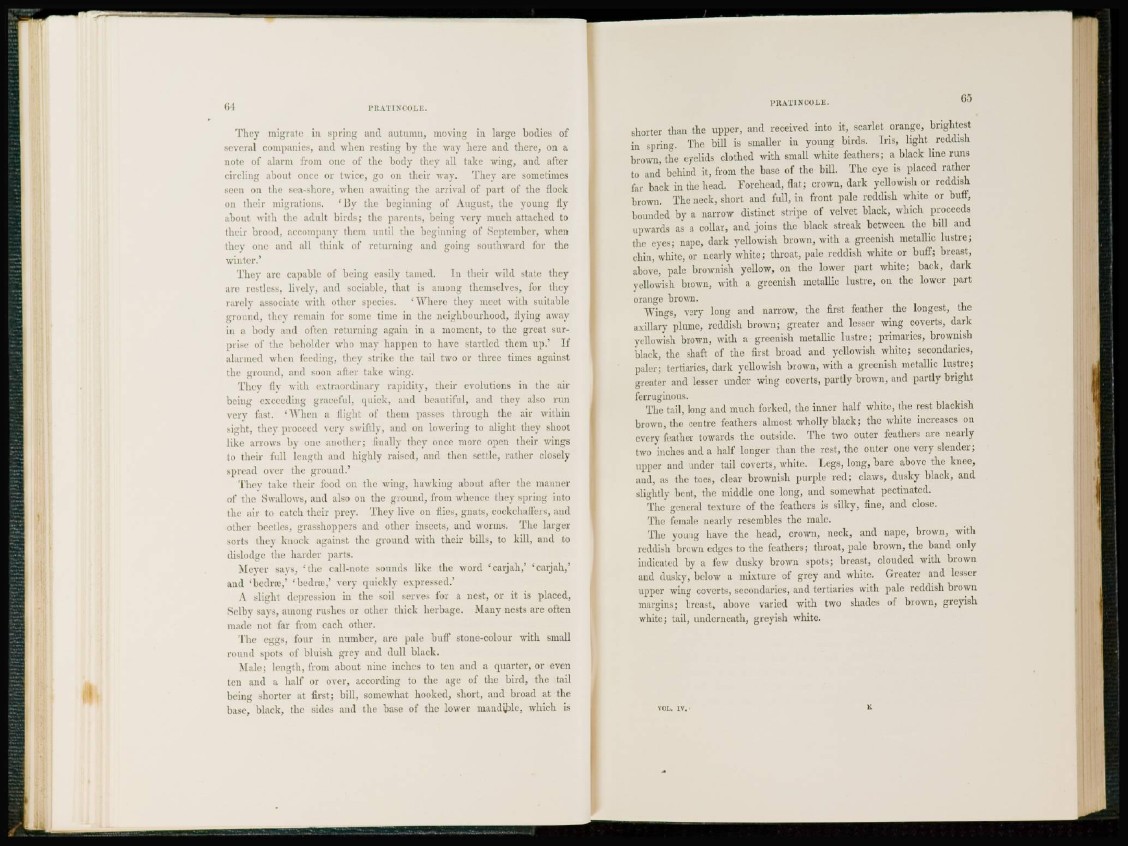
Ill PRATINCOLE.
They migrate in spring and autumn, moving in large bodies of
several companies, and when resting by the way here and there, on a
note of alarm from one of the body they all take wing, aud after
circling about once or twice, go on their way. They are sometimes
seen on the sea-shore, when awaiting the arrival of part of the flock
on their migrations. 'By the beginning of August, the young fly
aboul with the adult birds; the parents, being very much attached to
their brood, accompany them until the beginning of September, when
they one and all think of returning and going southward for the
winter.'
They arc capable of being easily tamed. In their wild state they
are restless, lively, and sociable, that is among themselves, for they
rarely associate with other species. 'Where they meet with suitable
groi nd, they remain for some time in the neighbourhood, flying away
in a body and often returning again in a moment, to the great surprise
of the beholder who may happen to have startled them up.' If
alarmed when feeding, they strike the tail two or three times against
the ground, and soon alter take wing.
They fly with extraordinary rapidity, their evolutions in the air
being exceeding graceful, quick, and beautiful, and they/ also run
very fast. 'When a flight of them passes through the air within
sight, they proceed very swiftly, aud on lowering to alight they shoot
like arrows by one another; finally they once more open their wings
to their full length and highly raised, and then settle, rather closely
spread over the ground.'
They take1 their food on the wing, hawking about after the manner
of the Swallows, and also on the ground, from whence they spring into
the air to catch their prey. They live on flies, gnats, cockchaffers, and
other beetles, grasshoppers and other insects, and worms. The larger
sorts they knock against the ground with their bills, to kill, and to
dislodge the harder parts.
Meyer says, ' t h e call-note sounds like the word 'carjah,' "carjah,'
and ' b e d n e , ' 'bedm1 , ' very quickly expressed.'
A slight depression in the soil serves for a nest, or it is placed,
Srlbv savs, among rushes or other thick herbage. Many nests are often
made not far from each other.
The eggs, four in number, arc pale buff stone-colour with small
round spots of bluish grey and dull black.
Male: length, from about nine inches to ten and a quarter, or even
ten and a half or over, according to the age of the bird, the tail
being shorter at first; bill, somewhat hooked, short, and broad at the
base, black, the sides and the base of the lower inaudible, which is
PRATINCOLE.
shorter than the upper, and received into it, scarlet orange, brightest
in spring. The bill is smaller in young birds. Iris, light reddish
brown, the eyelids clothed with small white feathers; a black line runs
to and behind it, from the base of the bill. The eye is placed rather
far back in the head. Forehead, flat; crown, dark yellowish or reddish
brown. The neck, short and full, in front pale reddish white or buff,
hounded by a narrow distinct stripe of velvet black, which proceeds
upwards as a collar, aud joins the black streak between the bill and
the eyes; nape, dark yellowish brown, with a greenish metallic lustre;
chin, white, or nearly white; throat, pale reddish white or buff; breast,
above, pale brownish yellow, on the lower part white; back, dark
yellowish brown, with a greenish metallic lustre, on the lower part
orange brown.
Wings, very long and narrow, the first feather the longest, the
axillary plume, reddish brown; greater and lesser wing coverts, dark
yellowish brown, with a greenish metallic lustre; primaries, brownish
black, the shaft of the first broad and yellowish white; secondaries,
paler; tcrtiaries, dark yellowish brown, with a greenish metallic lustre;
greater and lesser under wing coverts, partly brown, aud partly bright
ferruginous.
The tail, long and much forked, the inner half white, the rest blackish
brown, the centre feathers almost wholly black; the white increases on
every feather towards the outside. The two outer feathers are nearly
two inches and a half longer than the rest, the outer one very slender;
upper and under tail coverts, white. Legs, long, bare above the knee,
aud, as the toes, clear brownish purple red; claws, dusky black, and
slightly bent, the middle one long, and somewhat pectinated.
The general texture of the feathers is silky, fine, and close.
The female nearly resembles the male.
The young have the head, crown, neck, and nape, brown, with
reddish brown edges to the feathers; throat, pale brown, the band only
indicated by a few dusky brown spots; breast, clouded with brown
and dusky, below a mixture of grey and white. Greater and lesser
upper wing coverts, secondaries, and tertiaries with pale reddish brown
margins; breast, above varied with two shades of brown, greyish
white; tail, underneath, greyish white.